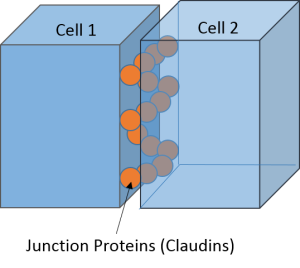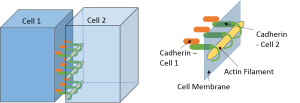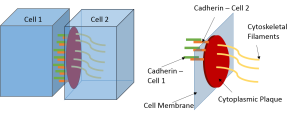Research 101: Junction, Junction, What’s Your Function?
Why Cell Junctions?
Recent research in fetal-onset hydrocephalus has shown that abnormalities in cell junctions, specifically gap and adherens junctions, may play a large role in the onset of ventriculomegaly and abnormal brain development. The research shows that the layer of cells surrounding the ventricles becomes disrupted. By understanding why and how these disruptions occur, scientists may be able to repair or replace abnormal junctions and prevent or arrest the development of hydrocephalus.
What Are Cell Junctions?
Cell junctions are structures that connect cells to one another. There are four main types of cell junctions and each has a specific function. Let’s take a look at the different types!
Gap Junctions:
When cells are very close together, but not quite touching, gap junctions create a physical connection and provide a channel for direct communication between cells. Gap junctions allow ions and small molecules to pass directly from the inside of one cell to the inside of a neighboring cell. Gap junctions have a cylindrical shape and are made up of proteins called connexins. A good example for gap junctions is your heart. In order for your heart to beat, an electrical signal has to pass in a wave through your heart muscle. Gap junctions between the muscle fibers (cells) allow the signal to pass from one fiber to the next. Without gap junctions your heart would not beat properly!
Tight Junctions:
Tight junctions merge cell membranes together to form a strong, impenetrable barrier. When many cells are linked together, they form a wall that does not allow anything located on one side to pass to the other side. In other words, tight junctions allow your body to keep areas separated. Claudins and other proteins form these junctions. Here’s an example. Think of your stomach. Would you want digested food and acid to easily pass through the walls of your stomach to the rest of your body? No! Well that’s why tight junctions are so important!
Adherens Junctions:
Adherens junctions provide a stiff, mechanical connection between cells to prevent the cells from moving position in relation to each other. In a sense, adherens junctions anchor cells to one another. The main linking proteins arecadherins. Your heart, again, is very helpful to understand this junction! As your heart beats it expands and contracts. You want all the cells to stay in line and move in the same direction as your heart beats. Adherens junctions keep your heart moving in the right direction!
Desmosomes:
This type of junction prevents cells from being pulled apart. The junction is so strongly linked to the structure of the cell that, if something managed to pull the two cells apart, the cells themselves would be damaged. Cadherins are also the main protein in desmosomes. The cadherins attach to the cytoplasmic plaque of the cell. For desmosomes, think of your skin. Your skin is pretty tough right? Your skin cells have a very strong connection and it takes force to break skin apart. Your skin is protecting everything inside your body and so the connections need to be strong! Well desmosomes really are a great junction for that!




No comments:
Post a Comment